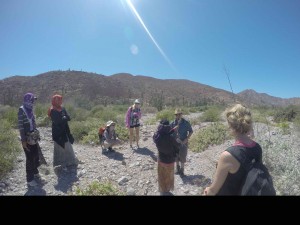According to a 2012 article by National Geographic titled “Vanishing Languages,” a language dies every 14 days (http://ngm.nationalgeographic.com/2012/07/vanishing-languages/rymer-text). This article describes three of the world’s most endangered languages. One of these languages, Cmiique Iitom, is the traditional language of the Seri, or Comcaac as they refer to themselves. As my colleagues have described in previous posts, the Seri invited us and joined our journey to their traditional home of Tiburon Island. Something that I noticed during our two trips to Tiburon Island was that two of our Seri guests, Mayra and Betsabe, constantly took notes during our lectures and as we explored the island. They even interviewed each other about specific topics related to their culture. It felt extremely special for me to get to learn about the Seri culture and history from and with our Seri guests.
We received more context for this co-learning later on in our trip. Following our first trip to Tiburon Island, we had the pleasure of meeting Cathy Moser Marlett and her husband, Steve Marlett. This impromptu meeting at the Prescott College’s field station felt as if we were meeting two legends in the Sonoran world. We had heard about Cathy and Steve through our previous discussions with Ben and Xavier. Cathy was raised among the Seri in El Desemboque. Her parents, Edward Moser and Mary Beck Moser, were American linguists that came to live with the Seri in 1951. Her parents, in addition to studying linguistic, cultural, and social aspects of the community, played many roles to help the Seri. Mary served the tribe as nurse and midwife and they both assisted with other medical and physical needs. One of their biggest contributions to the Seri was the translation of the New Testament, which they completed alongside a Seri man, Roberta Herrera Marcos.
Much of Edward and Mary’s efforts with the Seri were the collection and publishing of works on the Seri language and culture. Cathy and Steve have continued these efforts today. The husband and wife team described some of their more recent projects including a book for Cathy and classes for Seri men and women by Steve. Cathy’s book, titled Shells on a Desert Shore (http://www.uapress.arizona.edu/Books/bid2479.htm), is a beautiful book that describes the Seri knowledge of mollusks and includes names, folklore, history, and uses of each. Something we continually heard from those who studied the Seri was how one species in the English language could have multiple words in Seri. For example, the green turtle has ten different names in Seri depending on variables such as age, sex, or reproductive stage.

Steve’s work gave me greater insight into Mayra and Betsabe’s practices during our trips to Tiburon. He works with Seri men and women to help them express themselves through their own language in written form. Most recently, he has taught them how to interview one another about their language and culture. These videos are then edited and given back to the community for their own use. Although he said Mayra and Betsabe have not taken part in the interview classes, they seemed to be employing a similar strategy during our trips. In addition to interviewing one another, they also recorded videos of themselves and other Seri guests on the trip singing traditional Seri songs. They explained they want to ensure these stories, songs, and their language are passed down from generation to generation. All Seri we met with seemed to think their language or culture was in danger of being lost.
After learning more about the Seri culture and language directly from the Seri and others deeply ingrained in the community, I realized what a unique experience this was. We were able to experience a culture that had survived attack by the Spanish and then the Mexicans. They have been able to preserve their traditions largely by distancing themselves from outsiders. I felt lucky to be one of the outsiders they agreed to let in.
